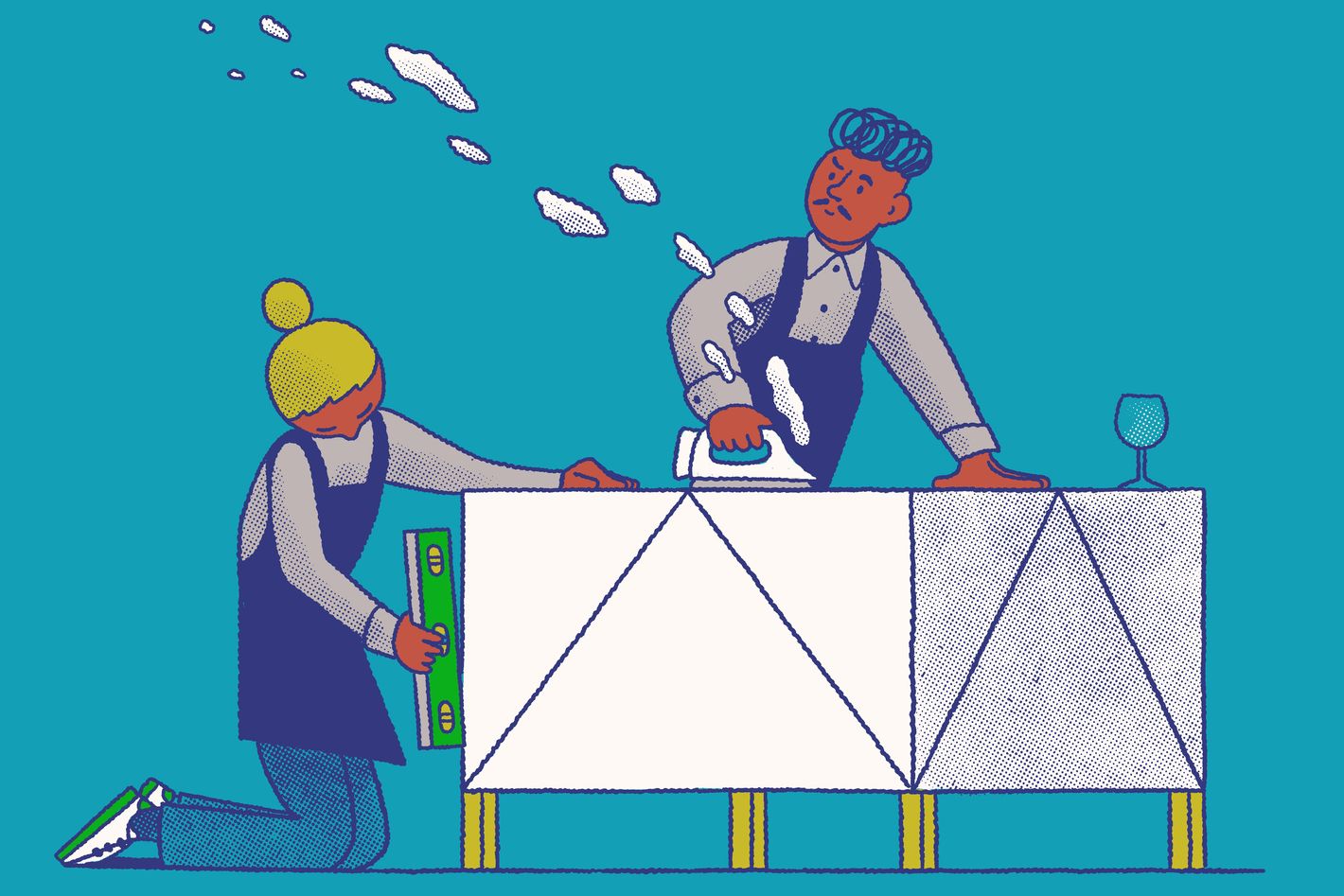when you want, where you want.
We’re Doing White Tablecloths Again
 Illustration: Robert Samuel Hanson
Illustration: Robert Samuel Hanson
Fifteen years ago, New York Post critic Steve Cuozzo bemoaned the “infantilization of dining” as white tablecloths — elegant, urbane — disappeared from the city’s upscale dining rooms. It was a creep of casualization as diners were increasingly excited to eat Millennium Falco pizzas off of reclaimed lumber or to slurp ramen from a barstool. “For so long, the aesthetic of a Brooklyn restaurant was raw brick and Edison bulbs,” says Tim Meyers. “At least in Williamsburg, we’re thankfully moving past that.” When Meyers was planning his restaurant, Field Guide, which opened on Kent Avenue in November, he decided early in the design process that he’d include white tablecloths. “It’s a signal of, Okay, let’s unplug — we’re gonna have a nice meal,” he says. “There’s a tactile element to the white tablecloths that I don’t think a lot of people appreciate; it’s nicer to set your forearms on a warm tablecloth than a cold, hard table.”
Though a white tablecloth can cost a restaurant less than $1 per use to rent from a linens company, all of the necessary logistics and ironing — Meyers cycled through a number of irons before landing on the CHI Professional irons that his staff now uses — may be part of why restaurateurs gave up on tablecloths in the first place. In a December 2006 column for the New York Times, restaurateur Donatella Arpaia predicted the future would see “more restaurants with no tablecloths, even upscale restaurants, because linens are crazy.”
Arpaia was right, and it wasn’t until a couple of years ago that spots like Jupiter and Torrisi started to arrive with starched linens on opening day. Now, crisp white tablecloths are very much back, at such new spots as Bridges, Brass, and Borgo. “People are looking for a night out in a different way,” says Brass owner Nick Hatsatouris. He has never owned a restaurant with tablecloths until now and thinks that part of the shift back to formality has to do with COVID. “There was a period of time when we were eating in outdoor sheds or at picnic tables. And I think we made the most of it, but coming out of that, we’re in this period of going out as an experience.”
Dennis Spina, who worked at the Roebling Tea Room in Williamsburg for about a decade and now owns Cafe Kestrel in Red Hook, is similarly happy to be done with what he calls the “Peaky Blinders” era of industrial design. “A lot of that stuff came out of necessity,” he explains. “Reclaimed wood was cheaper. Industrial lighting was cheaper.” Skipping tablecloths was, of course, cheaper too.
“I think things got a little loose, and then they got unwieldy,” Spina adds. He opted for white tablecloths at Cafe Kestrel to provide a “cozier” feel and help absorb sound, keeping the tiny, 19-seat dining room from getting too percussive. “We deserve some nice things every once in a while,” he says. “If I pay $300 for dinner, it’s okay to not want a dirty wood table.”
Spina and Meyers both contract Arrow Linen for their tablecloths. John A. Magliocco Jr., Arrow’s general manager, likes to cite a restaurant consumer study from Sparks Research that showed that consumers associate tablecloths with better food quality and are willing to pay more for food served on linens. He also points out that today’s diners may be looking for a more transportive experience than the casual diners of previous decades: “When people go out to dinner now, they’re treating themselves,” he says. “They’re expecting to be in an environment that’s different from being at their house.”
But to a generation of employees who came up in the bare-table era, the arrival of any linen comes with a learning curve. Lee Hanson and Riad Nasr serve food on bare tables at their first two restaurants — Frenchette and Le Rock — but modeled the red-and-white-checked tablecloths they use at Le Veau d’Or after a 1955 postcard of the restaurant with similar linens (over which they drape white paper). Those are custom-made in France, to accommodate the restaurant’s seven different table sizes. “I’ve never worked with a tablecloth before, and neither has any of my staff,” says Emilie Campbell, the restaurant’s general manager. “We’re like, Ooh, what’s a crumber?”
At least one diner is happy to see these changes: “Am I gratified that some people are finally coming to their senses?” says Cuozzo, all these years after his pro-linens manifesto in the Post. “Yeah, I suppose so. I believe tablecloths have a very civilizing influence on restaurants — I hope it continues.”
Related
All Rights Reserved. Copyright , Central Coast Communications, Inc.